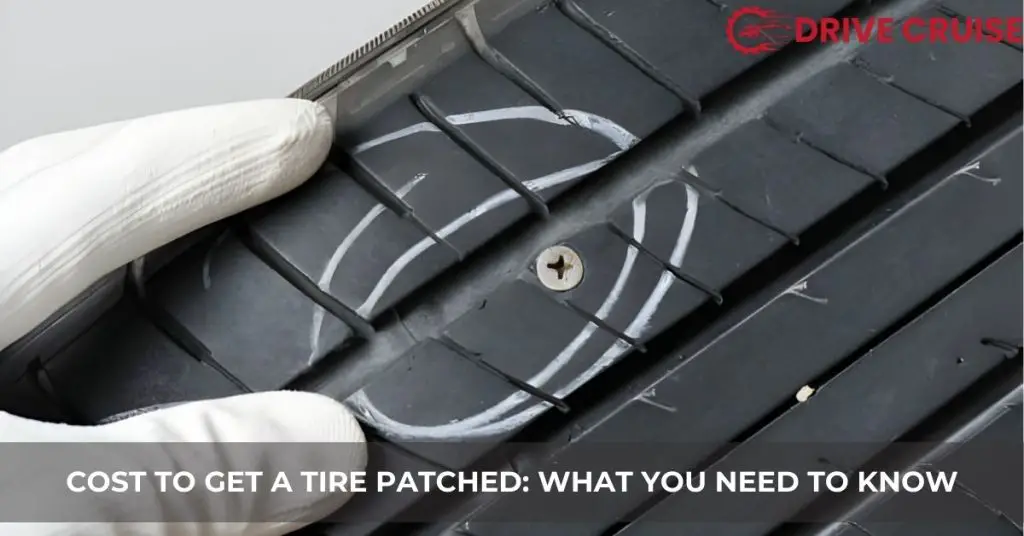We’ve all been there – cruising down the road when suddenly, our ride doesn’t feel quite right. A quick check reveals the dreaded flat tire. It’s an inconvenience, sure, but not the end of the world, especially when a patch can often save the day. But how much does it cost to get a tire patched? Let’s dive into the nitty-gritty of tire repair costs, so we’re all prepared the next time a nail decides to get cozy with our tires.
Navigating the world of auto maintenance can be a bit bewildering, with prices varying widely from one service provider to another. We’re here to shed some light on what you can expect to shell out for a tire patch, ensuring you’re not caught off guard. Whether you’re a seasoned motorist or a newbie behind the wheel, understanding the cost of getting a tire patched is essential knowledge that’ll keep us rolling smoothly.
Understanding the Cost to Get a Tire Patched
After highlighting the inconvenience of encountering a flat tire and emphasizing the need for preparedness, let’s delve into understanding the cost to get a tire patched. The price for tire repair services can vary widely based on several factors, including location, service provider type, and the severity of the tire damage.
Typically, tire patching services range from $10 to $20 for a standard patch job at local tire shops and auto repair centers. This cost-effective solution is not just about affordability; it ensures safety and extends the life of the tire. However, it’s crucial to note that not all damage can be patched. For example, punctures larger than a quarter-inch or damage on the tire’s sidewall usually require tire replacement, significantly increasing the cost.
Automotive dealerships might charge more for the same service, with prices possibly reaching up to $25 to $40. The higher cost at dealerships often reflects the use of specialized equipment or brand-specific expertise, offering added peace of mind for some drivers.
Additionally, roadside assistance services provide convenience with on-the-spot repairs, but this convenience comes at a premium. Prices for mobile tire patching can start from $50 and go up based on your location and the urgency of the service.
For individuals with memberships in automotive clubs like AAA, some of the costs might be covered or discounted, offering another layer of financial relief. It’s essential to check your membership benefits for details on tire repair services, as this could significantly reduce out-of-pocket expenses.
While the cost to get a tire patched may seem minor at first glance, understanding these variances prepares us for making informed decisions when the situation arises. Choosing the right service provider not only impacts our wallets but also ensures our safety on the road.
Common Types of Tire Damage
Understanding common types of tire damage can significantly impact the cost to get a tire patched. These damages determine whether a tire can be safely repaired or if it needs replacement. Here, we delve into the specifics.
Punctures
Punctures are the most frequent type of tire damage, often caused by nails, screws, or other sharp objects on the road. Tires with punctures less than 1/4 inch in diameter, located on the tread, are typically repairable. The repair process involves plugging or patching, contributing to the lower end of repair costs.
Cuts and Slices
Cuts and slices in a tire can occur from sharp debris or edges on the road. The repairability of such damage depends on its length and location. If the cut is on the sidewall or is too long on the tread, it usually deems the tire unsafe for repair, thereby increasing the overall cost due to the need for replacement.
Sidewall Damage
Damage to the sidewall poses significant safety risks. The sidewall is vital for maintaining the tire’s structural integrity, and any damage here often means the tire cannot be safely repaired. Such scenarios require tire replacement, influencing the higher spectrum of tire maintenance costs.
Impact Damage
Impact damage, or a bulge in the tire, results from hitting potholes, curbs, or other objects with significant force. This type of damage affects the internal structure of the tire, creating weak spots. Like sidewall damage, impact-damaged tires usually necessitate replacement rather than repair.
Age and Wear
While not a type of damage from an external event, the age and wear of a tire influence repair decisions. Over time, tires wear down, and the tread depth decreases. Severely worn or old tires may not be repairable, emphasizing the importance of regular tire maintenance to avoid the higher costs associated with replacement.
By recognizing these types of damage, drivers can make informed decisions on whether a tire patch is feasible or if they’re facing a tire replacement scenario, impacting the overall cost. Regular inspections and maintenance play a crucial role in identifying damage early and potentially saving on tire repair or replacement costs.
Where to Get Your Tire Patched
After recognizing the types of tire damage and understanding the potential need for a patch, finding the right place for this service is the next crucial step. Several options are available, each offering unique benefits depending on your situation.
Local Auto Repair Shops
Local auto repair shops are a go-to for many when it comes to tire repair. They often provide quick and affordable services. The technicians at these shops have the expertise to assess the damage and recommend the best course of action, be it patching or replacement. Pricing varies based on the shop’s location and the extent of the damage but typically ranges from $10 to $20.
Dealerships
If your vehicle is under warranty or you prefer services directly from the manufacturer, heading to a dealership might be the best choice. Dealerships usually charge a bit more, with costs ranging from $20 to $30 for a tire patch. However, they use parts and materials approved by the manufacturer, ensuring a high quality of service.
Tire Specialty Stores
Tire specialty stores, such as Firestone or Goodyear, focus solely on tires and related services. They might offer the most comprehensive assessment and have a wide range of tires in case your tire needs replacing instead of patching. Prices at these venues tend to be competitive, falling within the $15 to $25 range.
Roadside Assistance Services
For those unexpected moments, roadside assistance services provide convenience by coming directly to you. This option is perfect if the tire damage occurs on the road and you’re unable to reach a repair shop safely. Membership with an auto club or insurance might cover the cost partially or entirely, but without coverage, the service fee can start around $50, varying by location and service provider.
Each of these options presents a viable path to getting your tire patched, reflecting various price points, convenience levels, and service types. Consider your situation, whether it’s an emergency repair or routine maintenance, and choose the option that best fits your needs.
How to Save Money on Tire Patching
After discussing the importance of understanding tire repair costs and outlining where to get a tire patched, let’s dive into how we can save money on tire patching. Minimizing expenses without compromising on quality is crucial, especially when it comes to maintaining our vehicle’s tires.
First off, regularly inspecting tires for any signs of damage or wear can prevent bigger, more expensive repairs down the line. Catching a puncture early means it’s more likely to be patchable, avoiding the cost of a new tire.
Secondly, leveraging warranties can be a game-changer. Many tires come with manufacturer warranties that might cover the cost of repairs, including patching. Always check your tire’s warranty policy to see if the repair might be covered.
Another way to save is to shop around for the best prices. Prices for tire patching can vary widely between service providers, so it pays to call multiple shops to compare rates. Remember, cheaper isn’t always better; we’re looking for quality service at a fair price.
Also, consider investing in a tire repair kit as a cost-effective solution for minor punctures. These kits are relatively inexpensive and can be a handy, temporary fix until getting to a professional. It’s a good idea to learn how to use one properly, ensuring you can safely patch a tire in a pinch.
Lastly, look for promotions or coupons. Many tire repair shops and auto service centers offer discounts or special deals on tire patching and other maintenance services. Keeping an eye out for these promotions can significantly reduce the cost.
By following these tips, we can save money on tire patching while ensuring our vehicle remains safe on the road. Regular maintenance, smart shopping, and taking advantage of available resources help us stay cost-effective in managing tire repairs.
The Importance of Timely Tire Repairs
Following our exploration of cost-effective methods for patching tires and identifying the right service providers, it becomes crucial to stress the importance of timely tire repairs. Ignoring or delaying the patching of a damaged tire can lead to more serious issues, escalating costs significantly and potentially compromising vehicle safety.
First, addressing tire damage promptly helps prevent further deterioration. A small puncture can expand, leading to irreparable damage if not attended to quickly. Regular inspections enable early detection, ensuring minor issues don’t escalate into major problems.
Second, quick repairs enhance safety. A damaged tire can affect the vehicle’s handling and braking, increasing the risk of accidents. Ensuring tires are in good condition is paramount for the safety of passengers and other road users.
Third, timely patching saves money in the long run. Repairing a minor puncture is considerably cheaper than replacing a tire. By fixing problems early, we can extend a tire’s lifespan, delaying the need for costly replacements.
Moreover, maintaining properly patched tires contributes to fuel efficiency. Compromised tires can increase rolling resistance, leading to higher fuel consumption. By keeping tires in optimal condition, we ensure our vehicle runs as efficiently as possible, saving money on gas.
Additionally, the environmental impact is non-negligible. Extending tire life through regular maintenance and timely repairs minimizes waste, contributing to environmental conservation efforts.
Lastly, avoiding emergency repairs by addressing tire issues quickly ensures we aren’t stranded or inconvenienced by sudden tire failures. Regular maintenance and timely repairs keep us on the road, avoiding the hassle and danger of roadside emergencies.
In essence, timely tire repairs are a critical component of responsible vehicle maintenance. They not only ensure our safety but also contribute to cost savings and environmental sustainability, reinforcing the importance of addressing tire damage as soon as it’s detected.
Conclusion
We’ve explored the ins and outs of getting a tire patched, emphasizing the balance between cost, convenience, and quality. It’s clear that making an informed decision can lead to significant savings and ensure our vehicles remain safe on the road. By adopting strategies like regular inspections and taking advantage of discounts, we can manage expenses without compromising on quality. Let’s not forget the importance of addressing tire issues promptly. Doing so not only safeguards our safety but also contributes to our vehicle’s efficiency and reduces our environmental footprint. Together, let’s commit to responsible vehicle maintenance for a smoother, safer journey ahead.
Related Posts:
















